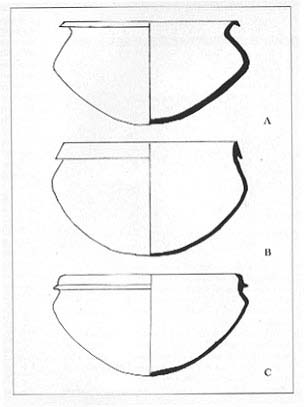Image Details

Courtesy Adam Zertal
Fashions in pottery change over time. Before and during the period of early Israel (Iron Age I, 1200–1000 B.C.E.), the common cooking pot went through three stages of development distinguished by the shape of the rims of the vessels. In the drawings, the left half of each one shows the intact vessel as seen from outside; the right half shows the appearance of the body of the vessel as if it had been sliced in half vertically. This latter view allows us to see the varying thickness of the body wall and the shape of the rim. Type A (top), the typical cooking pot used throughout Canaan during the Late Bronze Age (16th–13th centuries B.C.E.) and used by the earliest Israelites in Iron Age I, possessed an everted triangular rim. Type B (middle), characterized by a less pointy, tongued rim, gradually replaced the Type A vessel at the beginning of the 12th century, presumably as Israelite potters introduced their own variations on the Canaanite model. About the middle of the 11th century, Type C (bottom) became dominant. Featuring a long tongue on the rim, Type C lasted through the tenth century. By charting the relative quantities of the different pottery types found during surface surveys at various sites, it is possible to order the sites into a finely tuned chronological sequence. When the distribution of these chronologically ordered sites is analyzed, it becomes possible to trace the movement, or expansion, of the Israelite settlements. Although the method is not exact, the data so far support an early Israelite entry and expansion from the east, near the Jordan River, to the west through the territory of Manasseh.
